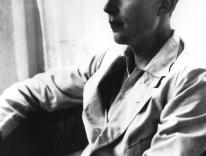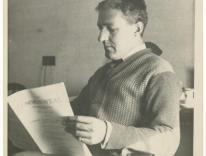Nine years ago, when our mother was dying of lung cancer, my sisters and I considered moving her to a hospice. Like many who are dying, my mother viewed hospice with ambivalence and dread, and by the time she agreed, she was too fragile to move. Which was too bad, since the facility I toured—the nation’s first residential hospice, in Branford, CT—was a remarkable place, with an aura of sunlit serenity and a view of the Connecticut coastline that looked strangely Californian. I knew it was exactly the right place for my mother, who had long felt a deep pull toward ocean vistas. But we were too late. Her fear of death prevented her from having the kind of death that would have suited her best.
I was reminded of this, and many other end-of-life predicaments and paradoxes, by Marietta Pritchard’s new book, The Way to Go: Portrait of a Residential Hospice. A retired journalist in her seventies, and wife of Amherst College English professor (and Commonweal contributor) William H. Pritchard, she offers a tender and nuanced account of life—and death—at The Fisher Home, a nine-bed residential hospice in Amherst, Mass, where she has worked as a volunteer for years.
The Way to Go alternates passages from Pritchard’s volunteer journal with short chapters profiling residents and staff at The Fisher Home. Written in the present tense, the book reminded me of Tracy Kidder’s low-key, meticulously detailed studies of institutions, companies and communities, and the individuals who make them thrive. With discerning appreciation Pritchard describes the efforts of nurses, bereavement counselors, doctors and administrators to create “a medically conscientious haven, an oasis for dying people, as well as for their families and friends.”
“Hospice seeks to normalize death,” Pritchard writes, noting what a challenge that is in a culture in which death typically figures as “the unspeakable... the event that cannot be faced.” Normalizing death turns out to require “undoing the habits of lifetimes;” withholding medical treatment from the dying, for instance, can contravene both the training of health care workers and the loving instincts of family members. “It is hard to relinquish the impulse to feed and hydrate a loved one,” Pritchard acknowledges. But hospice principles recognize that when a person is “actively dying,” pushing food or liquids can actually increase discomfort. So don’t start an intravenous drip. Keep them comfortable with mouth swabs and sips of water. Let the peaceful death happen. “Thank you all,” the volunteer coordinator tells her staff after the death of a resident, “for another good ending.”
Hospice care for the dying involves tradeoffs and dilemmas, like how to adjust medication enough to alleviate pain, but not so much as to obliterate alertness. Pritchard chronicles the sometimes cruel process of being “decertified”—temporary upticks in health that disqualify residents for hospice, forcing them to leave. For those who stay, death looms sooner rather than later (the average stay at Fisher is three weeks), and The Way to Go offers insight into their ways of reckoning with it. Pritchard pays attention to family complexities, describing cases in which the dying person is ready but his family is not, and the obverse as well.
For the residents, dying is an intense, inward, and often idiosyncratic process. One of them, who spends many hours looking out the window, is unsettled when a well-meaning friend, hoping to beautify the panorama, presents her the gift of a hummingbird feeder and a potted flowering plant. “She had gotten used to looking out that window, watching the clouds roll over an austere view,” Pritchard writes. “Now there was more visual complication there, something to pull her attention away from the inner order she was trying to make.”
Her portraits of residents include both the religiously faithful and the skeptical, and all types of personalities—the cranky, the dour, the serene, the raucously irreverent. A rabbi, conducting a memorial service for one resident, recalls his last meeting with the dying man. “As I was holding his hand and speaking with him, he suddenly opened his eyes and took a break from breathing his last to inquire of me: ‘Who the fuck are you?’” Approaches to dying are as many and various as we are ourselves. Some residents achieve peace. Others fight with all their might, raging against what lies ahead.
The Way to Go studies a hospice in a liberal, largely agnostic college community. The Catholic hospice movement has its own tradition and culture, but it reflects many of the same core principles—and provides many of the same spiritual benefits to those who work in it. As John Paul II noted in a 2004 address to the Pontifical Council for Health Pastoral Care, “Daily experience teaches that the persons most sensitive to the suffering of others and who are the most dedicated to alleviating the suffering of others are also more disposed to accept, with God’s help, their own suffering.”
For Pritchard, volunteering at The Fisher Home involves no dearth of moving moments, as when she sits a deathbed vigil for one particularly beloved resident and finds herself humming “Jesus, Lover of My Soul” as he expires. Though her days there can be hectic, they nevertheless provide “a kind of meditative quality.” Well aware that she herself has far more life behind her than ahead, Pritchard finds in The Fisher Home a salutary way of focusing on ultimate things. “Volunteering at a hospice keeps me from forgetting that life ends,” she writes, and “also teaches me that life goes on until its end, and that the last stretch can be as valuable and satisfying as any other part of our existence, if we allow it to happen that way.” Bravo.


